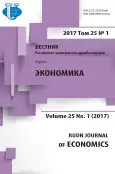CURRENT TRENDS IN THE SOCIAL-ECONOMIC INTEGRATION OF GYPSY MIGRANTS IN THE EUROPEAN UNION
- Authors: Marushiakova E1,2, Popov V1,2
-
Affiliations:
- School of History at University of St. Andrews
- Institute of Ethnology and Folklore Studies with Ethnographic Museum at Bulgarian Academy of Sciences
- Issue: Vol 25, No 1 (2017)
- Pages: 112-121
- Section: ARTICLES
- URL: https://journal-vniispk.ru/2313-2329/article/view/343025
- DOI: https://doi.org/10.22363/2313-2329-2017-25-1-112-121
- ID: 343025
Cite item
Full Text
Abstract
About the authors
E Marushiakova
School of History at University of St. Andrews; Institute of Ethnology and Folklore Studies with Ethnographic Museum at Bulgarian Academy of Sciences
Email: emp9@st-andrews.ac.uk
PhD, Professor, School of History, University of St. Andrews, Scotland, UK; Institute of Ethnology and Folklore Studies with Ethnographic Museum at Bulgarian Academy of Sciences, Sofia (Bulgaria) South str., 71, St Andrews Scotland, UK; Moskovska str., 6a, Sofia, Bulgaria, 1000
V Popov
School of History at University of St. Andrews; Institute of Ethnology and Folklore Studies with Ethnographic Museum at Bulgarian Academy of Sciences
Email: vp43@st-andrews.ac.uk
PhD, Professor, School of History, University of St. Andrews, Scotland, UK; Institute of Ethnology and Folklore Studies with Ethnographic Museum at Bulgarian Academy of Sciences, Sofia (Bulgaria) South str., 71, St Andrews Scotland, UK; Moskovska str., 6a, Sofia, Bulgaria, 1000
References
- European Roma Right Centre (ERRC). Campland: Racial segregation of Roma in Italy. Budapest: European Roma Right Centre, 2000
- Grill J. (2011). From Street Busking in Switzerland to Meat Factories in the UK: A Comparative Study of Two Roma Migration Networks from Slovakia / In: Kaneff, D., Pine, F. (Eds). Emerging Inequalities in Europe: poverty and transnational migration. London: Anthem Press. Pp. 79-102
- Grill J. (2012). “It’s building up to something and it won’t be nice when it erupts”: The making of Roma / Gypsy migrants in post-industrial Scotland // Focaal. 62 (1). Pp. 42-54
- Grill J. (2012). ‘Going up to England’: Exploring Mobilities among Roma from Eastern Slovakia // Journal of Ethnic and Migration Studies. 38 (8). Pp. 1269-1287
- Klimova I., Pickup A. (2000). (Eds.) Romani Migrations: Strangers in Anybody’s Land? // Cambridge Review of International Affairs. XIII (2). Pp. 13-118
- Kotvanova A., Szep A. (2002). (Eds.) Migrácia a Rómovia. Historické sociálne a politické súvislosti. Bratislava: Slovenský inštitút medzinárodných štúdii
- Kovats A. (2002). (Ed.) Roma Migrations. Budapest: Hungarian Academy of Sciences - Institute of Minority Research
- Marushiakova E. (2008). Gypsy/Roma Identities in New European Dimension: The Case of Eastern Europe / In: Marushiakova E. (Ed.) Dynamics of National Identity and Transnational Identities in the Process of European Integration. Newcastle: Cambridge Scholars Publishing. Pp. 468-490
- Marushiakova E. (2014). Roma from Southeastern Europe: Living and Working in Migration // Re:work Working Paper. 15. Pp. 281-309
- Marushiakova E., Popov V. Gypsies (1997). (Roma) in Bulgaria. Frankfurt am Main: Peter Lang
- Marushiakova E., Popov V. (2006). De l’Est a l’Ouest. Chronologie et typologie des migrations tsiganes en Europe // Etudes Tsiganes. No. 27-28. Pp. 10-26
- Marushiakova E., Popov V. (2008). Migrations des Tsiganes en Europe, des ann es soixante a nós jours // Hommes et Migrations. 1275. Pp. 100-111
- Marushiakova E., Popov V. (2012). Gypsy migrations in Europe / In: Migration bridges in Eurasia. Collection reports and materials of the participants of the II international scientific-practical conference. Ed. by S.V. Ryazantsev. Moscow: Econ-Inform. Pp. 261-265
- Marushiakova E., Popov V. (2013). Roma Identities in Central, Southeastern and Eastern Europe / In: Kyuchukov, H., Rawashdeh, O. (Eds.) Roma Identity and Anti-Gypsyism in Europe. München: LINCOM. Pp. 40-52
- Marushiakova E., Popov V. (2013). Two Patterns of Roma Migrations from Southeastern Europe / In: Dimitrova, T., Kahl, T. (Eds.) Migration from and towards Bulgaria. Berlin: Frank and Timme. Pp. 227-244
- Marushiakova E., Popov V. (2013). Roma Migrations vs. Gypsy Nomadismus / In: SchrammelLeber, B., Tiefenbacher, B. (Eds.) Romani V. Papers from the Annual Meeting of the Gypsy Lore Society, Graz 2011. Graz: Grazer Linguistische Monographien. Pp. 113-134
- Марушиакова Е., Попов В. (2013). Миграции на цигани от Юго-Източна Европа. (История и съвременност) / In: Маева, М., Захова, С. (Eds.) Българите в Средиземноморието. Етнография на миграциите. София: Парадигма. Pp. 237-296
- Marushiakova E., Popov V. (2015). European Gypsy Migrations: Historical and Modern Patterns / In: Migration bridges in Eurasia. Materials of the VII international scientific and practical conference. Ed. by S.V. Ryazantsev. Moscow: Econ-Inform. Pp. 404-409
- Marushiakova E., Popov V. (2015). European Policies of Roma Social Inclusion: Catch 22? // Social Inclusion. 3 (5). P. 19-31
- Marushiakova E., Popov V. (2015). Identity and Language of the Roma (Gypsies) in Central and Eastern Europe / In: Kamusella, T., Nomachi, M., Gibson, C. (Eds.) The Palgrave Handbook of Slavic Languages, Identities and Borders. London: Palgrave. Pp. 26-54
- Marushiakova E. (2001). et al. Identity Formation among Minorities in the Balkans: The cases of Roms, Egyptians and Ashkali in Kosovo. Sofia: Minority Studies Society Studii Romani
- Matras Y. (1998). The development of the Romani civil right movement in Germany 1945-1996 / In: Tebbut, S. (Ed.) Sinti and Roma: Gypsies in German-speaking society and literature. New York: Berghahn. Pp. 49-64
- Matras Y. (2000). Romani migrations in the post-communist era: Their historical and political significance // Cambridge Review of International Affairs . 2000. 13 (2). Pp. 32-50
- Matras Y. (2002). Romani. A Linguistic Introduction. Cambridge: Cambridge University Press
- Reyniers A. (1999). Evaluation of Gypsy Populations and their Movements in Central and Eastern Europe and in some OECD Countries, focusing on the issues of migration, application for asylum, demography and employment. Occasional Papers. Paris: OECD
- Vidra Z. (2013). (Ed.) Roma migration to and from Canada: The Czech, Hungarian and Slovak case. Budapest: CEU
- Захова С. (2013). Формални и неформални мрежи на българи в Италия / In: Маева, М., Захова, С. (Ред.) Етнография на миграциите: Българите в Средиземноморието. София: Парадигма. Pp. 101-136
Supplementary files









